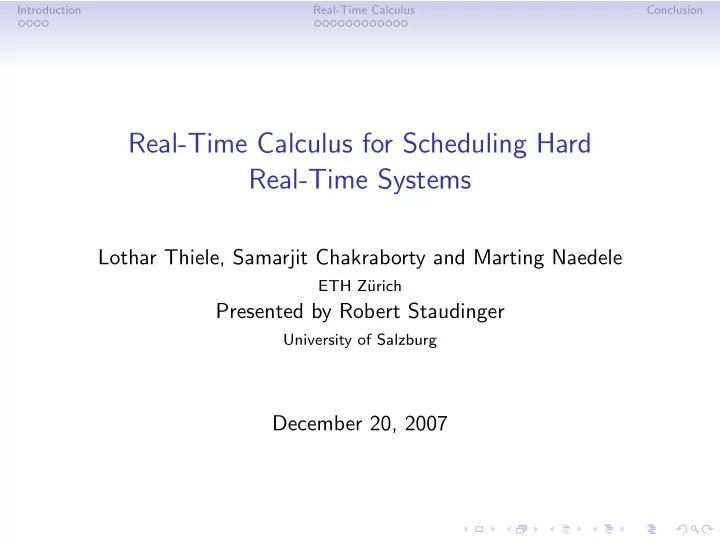

Introduction Real-Time Calculus Conclusion Real-Time Calculus for Scheduling Hard Real-Time Systems Lothar Thiele, Samarjit Chakraborty and Marting Naedele ETH Z¨ urich Presented by Robert Staudinger University of Salzburg December 20, 2007
Introduction Real-Time Calculus Conclusion Motivation Modular Performance Analysis and Design Space Exploration of Distributed Embedded Systems System complexity is increasing, a few domains: • Networks of sensors and actuators • Building automation • Car communication • Environmental monitoring • ...
Introduction Real-Time Calculus Conclusion Motivation Fundamental problems: • Handling non-functional and resource constraints • Design under multiple conflicting criteria • Performance vs power consumption • Data throughput vs error rate • ... • Trade-off between average performance and predictability
Introduction Real-Time Calculus Conclusion Motivation Modular Design Strategies
Introduction Real-Time Calculus Conclusion Motivation Modular Design Strategies – Vision Finite resources Requirements: • Buffer space • Distributed systems • Energy • Need for run-time adaptability • Communication • Allow for guarantees • Processing power • Time • ...
Introduction Real-Time Calculus Conclusion Real-Time Calculus In a Nutshell • Deterministic queueing theory • Hard upper and lower bounds are always found • No insight into average load of a system • Extension of Network Calculus (R. L. Cruz, 1991)
Introduction Real-Time Calculus Conclusion Real-Time Calculus
Introduction Real-Time Calculus Conclusion Real-Time Calculus Relationship Network Calculus Real-Time Calculus • Time (absolute) • Interval size ∆ (relative time) • Cumulative Function • Arrival Curve • Event stream R ( t ) • Event curve α l , α u • Resources C ( t ) • Resource curve β l , β u
Introduction Real-Time Calculus Conclusion Real-Time Calculus • Nodes are modeled as pure mathematical functions • Computation resources: CPU cycles • Communication resources: Transported number of bits
Introduction Real-Time Calculus Conclusion Real-Time Calculus
Introduction Real-Time Calculus Conclusion Real-Time Calculus Proposition 1: Basic Model For a processing node characterised by the capacity function C ( t ) and the incoming requests function R ( t ) we have C ′ ( t ) = C ( t ) − R ( t ) and R ′ ( t ) = min 0 ≤ u ≤ t { R ( u ) + C ( t ) − C ( u ) }
Introduction Real-Time Calculus Conclusion Real-Time Calculus Bounds Proposition 2: Request Curve For a given request function R , the minimum request curve α r can be calculated as α r = max u ≥ 0 { R (∆ + u ) − R ( u ) } Proposition 3: Delivery Curve For a given capacity function C , the maximum delivery curve β can be calculated as β = min u ≥ 0 { C (∆ + u ) − C ( u ) }
Introduction Real-Time Calculus Conclusion Real-Time Calculus Processing of Bounds Proposition 4: Remaining Delivery Curve Given request and capacity functions R and C , bounded by the request and delivery curves α r and β respectively, C ′ according to Prop. 1 is then bounded by the delivery curve β ′ (∆) = max 0 ≤ u ≤ ∆ { β ( u ) − α r ( u ) } Proposition 5: Delivered Computation Bounds Given request and capacity functions R and C , bounded by the request and delivery curves α r and β respectively, R ′ according to Prop. 1 is then bounded by the request curve α ′ (∆) = max u ≥ 0 { α r (∆ + u ) − β ( u ) }
Introduction Real-Time Calculus Conclusion Real-Time Calculus Calculation of Bounds c.f. S. Baruah, 1998 • Task graph: DAG with unique source and sync vertex • Vertex u is subtask • Associated with pair ( e ( u ) , d ( u )) • Requires e ( u ) time, finishes d ( u ) after being triggered • Directed edge ( u , v ) is control flow • p ( u , v ) is min time before v can be triggered
Introduction Real-Time Calculus Conclusion Real-Time Calculus Calculation of Bounds L j +1 = ( e ( j + 1) , d ( j + 1)) • Incremental algorithm for each edge ( k , j + 1) do • L i set of tuples ( f , ∆) for each tuple ( f , ∆) ∈ L k do L j +1 ∪ sequences of executions { ( f + e ( j + 1) , ∆ + p ( k , j + 1) i is last subtask + d ( j + 1) − d ( k )) } • L ( i ) list of tuples L ( j + 1) = L j +1 ∪ L ( j ) subtasks up to, including i Reduce sets L ( j + 1) and L j +1 Reduce removed tuples with less restrictive bounds
Introduction Real-Time Calculus Conclusion Real-Time Calculus Theorem 1 Given a task graph of n vertices, α d (∆) can be computed in O ( n 3 ) time if the execution times of the subtasks are equal, and in general it can be computed in pseudo-polynomial time.
Introduction Real-Time Calculus Conclusion Real-Time Calculus Proposition 6: Schedulability Test The capacity offered by a task T i can be described by the remaining delivery curve β ′ according to Prop. 4 where α r = � i − 1 j =1 . Task Ti meets all its deadlines if ( ∀ ∆)( β ′ (∆) ≥ α i d (∆))
Introduction Real-Time Calculus Conclusion Conclusion • Terse but concise paper • Key contribution is algorithm in polynomial time • Critique: request/arrival model and task graph model could be integrated better
Recommend
More recommend